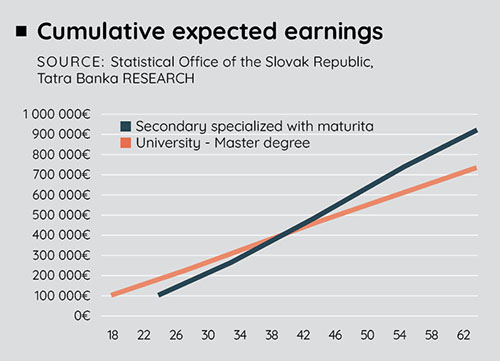The assumed reason behind this purported irrationality on the part of young adults is their laziness, focus on leisure, “millennial attitudes” (despite the fact that most millennials are already in their 30s, the author of this column included), and general snobbery when it comes to manual jobs.
However, once we look past the anecdotes and focus on cold, hard data, the decision to pursue tertiary education is perfectly rational and, ceteris paribus, increases one’s lifetime earnings. In other words, the market rewards even a mediocre university diploma more than good vocational education, and people adjust their behavior accordingly.
Tertiary graduates earn significantly more than secondary
Once a year, the Statistical Office of the Slovak Republic publishes a detailed data publication titled Structure of Earnings in the Slovak Republic, where one can find more details about wages and wage distribution in Slovakia. Looking at the data, we can see that the premium the market pays for a university degree is on average 47% above the wage of specialized secondary education. This figure might seem too high: when one does a quick search of job offers, the difference between entry-level jobs with university diploma requirements and without them is not that big. Furthermore, a lot of university graduates enter high-school level jobs. We can see it in the data as well: the premium of tertiary education is below 15% for employees under 30.

And herein lies the crux of the tale: the benefit of tertiary education really kicks in only after ten years of job experience. For employees older than 35, the premium is 40% and continues to rise to almost 60% for those over 45. This is mostly driven by the fact, that for blue-collar jobs, your entry wage is much closer to the ceiling than for university graduates. In other words, tertiary education is less about starting higher on the ladder of opportunity, and more about buying a taller ladder, where one can reach higher levels in their career.
Because the premium varies with age, and because high school graduates start earning sooner, it may be helpful to look at the difference in expected lifetime earnings. Between the ages of 18-64, we would expect a high school graduate to earn 690 ths EUR, while a university graduate is expected to earn roughly 200 ths more, nowadays an equivalent of a three-bedroom apartment in Bratislava and a lifetime premium of 28%.
But what about medians?
Of course, averages can be distorted by outliers and thus misleading. What if the university and high school graduates earn roughly the same but the averages are skewed by said outliers? Luckily, the aforementioned publication provides us not only with medians, but even quartiles and both top and bottom deciles of the distribution. At the median, the tertiary education premium is 36%. This means that a median wage for university graduates is 36% higher than the median wage for high school graduates. For the first quartile, the difference is still large and equals 30%. Only for the lowest 5% of earners does the premium shrink to 6%. However, at those wage levels, the nominal difference of 40 EUR per month on a 600 EUR salary is still quite significant.
At the other end of the distribution, the difference grows: the top 10% of employees with a university diploma earn 60% more than the top 10% of high school graduates. Looking at nominal amounts, 35% of high school graduates earn 1000 EUR per month or less, compared with just 13% of university graduates. However, 29% of tertiary graduates earn more than 2000 EUR per month, compared with only 8% of high school graduates. This underscores the value of tertiary education: it is not only about a guaranteed increase in lifetime earnings but also about buying a better ticket in the lottery: the earnings ceiling is significantly higher with tertiary education.
Caveats
Of course, this analysis looks at a snapshot in time. It says nothing about the selection bias between tertiary and secondary graduates: they are not randomly split into those groups but are in some meaningful ways different and that can potentially explain the difference in wages, rather than the diploma itself. Furthermore, the share of university graduates increases in time, which means that we should expect a decrease in the premium over time. At the same time, brain drain is an issue in Slovakia, meaning that the most talented and driven do not enter the labor market in Slovakia and do not form the “outliers” who would increase wages of university graduates. Nevertheless, the future is, inherently, unknowable. Today’s kids and young adults have to make a choice that will impact the material quality of their whole life. Based on today’s data, pursuing tertiary education in Slovakia is, from an earnings perspective, a rational choice.

Tibor Lorincz, Economic Analyst, Tatra banka, a.s.



Follow us